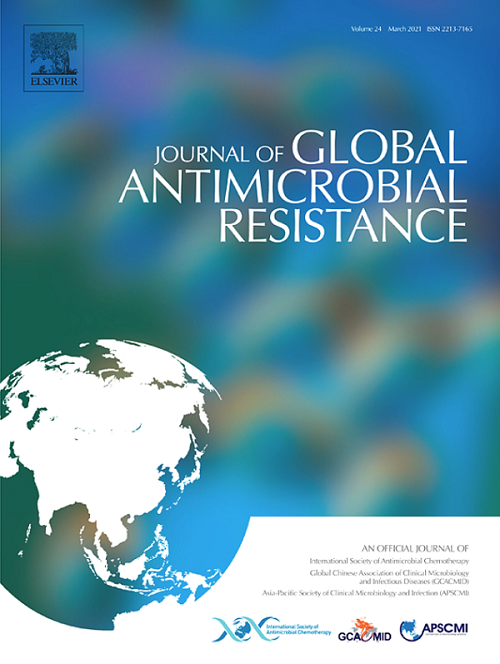孟加拉国达卡肺炎克雷伯菌感染的临床和基因组特征
IF 3.7
3区 医学
Q2 INFECTIOUS DISEASES
引用次数: 0
摘要
背景:肺炎克雷伯菌(Klebsiella pneumoniae, Kpn)是世卫组织的重点病原体,具有高抗菌素耐药性(AMR),已成为医院获得性肺炎和新生儿败血症的主要原因。目的:我们旨在确定孟加拉国达卡一组Kpn感染患者的临床特征,并对相关分离株进行表型和遗传表征。方法:回顾性提取2022年2月至9月在达卡医学院医院采集的临床标本中分离出克雷伯氏菌的患者的临床资料。我们使用标准微生物学技术来评估AMR,并使用全基因组测序(WGS)来评估优势谱系、常见荚膜(K)和O-多糖(O)抗原类型以及AMR和毒力基因。结果:共纳入98例患者,诊断为肺炎(38/ 98,39%)、伤口感染(29/ 98,31%)、尿路感染(29/ 98,31%)和菌血症(2/ 98,2%)。我们测试了分离株对八类抗生素的敏感性。98株菌株中,41%为多重耐药(MDR), 15%为广泛耐药(XDR), 16%为泛耐药(PDR)。3株(3%)对多粘菌素b耐药;4例(8%)患者死于PDR (n=2)、XDR (n=1)和MDR分离株(n=1)引起的感染。WGS显示出高度的基因组多样性,具有多种序列型(st), o型和k型;ST16:K81:OL101和ST43:K30:O1最常见。结论:我们的研究结果表明,孟加拉国Kpn分离株的抗菌素耐药性达到了惊人的水平,迫切需要改进治疗方式和开发疫苗。本文章由计算机程序翻译,如有差异,请以英文原文为准。
Clinical and genomic characterization of Klebsiella pneumoniae infections in Dhaka, Bangladesh
Background
Klebsiella pneumoniae (Kpn), a WHO priority pathogen with high rates of antimicrobial resistance (AMR), has emerged as a leading cause of hospital acquired pneumonia and neonatal sepsis.
Objective
We aimed to define the clinical characteristics of a cohort of patients with Kpn infection in Dhaka, Bangladesh and to perform phenotypic and genetic characterization of the associated isolates.
Methods
We retrospectively extracted clinical data about patients at Dhaka Medical College Hospital from whom Klebsiella spp was isolated from a clinical specimen collected between February and September 2022. We used standard microbiologic techniques to evaluate AMR and whole-genome sequencing (WGS) to assess dominant lineages, common capsular (K) and O-polysaccharide (O) antigen types, and AMR and virulence genes.
Results
Ninety-eight patients were included, with diagnoses of pneumonia (38/98, 39 %), wound infection (29/98, 31 %), urinary tract infection (29/98, 31 %) and bacteremia (2/98, 2 %). We tested isolates for susceptibility to eight classes of antibiotics. Of the 98 isolates, 41 % were multidrug resistant (MDR), 15 % were extensively drug resistant (XDR), and 16 % were pan-drug resistant (PDR). Three isolates (3 %) were resistant to polymyxin B. Outcome data were available for 46 patients; 4 patients (8 %) died from infections caused by PDR (n = 2), XDR (n = 1), and MDR isolates (n = 1). WGS revealed a high degree of genomic diversity, with multiple sequence types (STs), O-types and K-types represented; ST16:K81:OL101 and ST43:K30:O1 were the most prevalent.
Conclusion
Our findings suggest alarming levels of AMR among Kpn isolates in Bangladesh and a critical need for improved treatment modalities and vaccine development.
求助全文
通过发布文献求助,成功后即可免费获取论文全文。
去求助
来源期刊

Journal of global antimicrobial resistance
INFECTIOUS DISEASES-PHARMACOLOGY & PHARMACY
CiteScore
8.70
自引率
2.20%
发文量
285
审稿时长
34 weeks
期刊介绍:
The Journal of Global Antimicrobial Resistance (JGAR) is a quarterly online journal run by an international Editorial Board that focuses on the global spread of antibiotic-resistant microbes.
JGAR is a dedicated journal for all professionals working in research, health care, the environment and animal infection control, aiming to track the resistance threat worldwide and provides a single voice devoted to antimicrobial resistance (AMR).
Featuring peer-reviewed and up to date research articles, reviews, short notes and hot topics JGAR covers the key topics related to antibacterial, antiviral, antifungal and antiparasitic resistance.
 求助内容:
求助内容: 应助结果提醒方式:
应助结果提醒方式:


